Incan Vitrified Stones
Evidence of Vitrified Stonework in
the Inca Vestiges of Peru
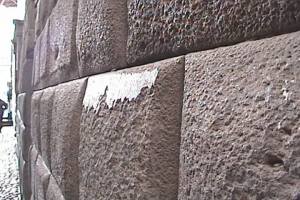

Snake in Vitrified Stone
Vitrified stones are simply stones that have been melted to a point where they form a glass or glaze. There is much debate in archaeological circles over the ancient examples under study for two reasons. Firstly, few cases are known to have been tested and even if they have been, there are many questions over how they were made.
Glassy rocks form naturally under conditions of high temperature and pressures found in and around volcanoes. Glass or glazes are traditionally created using a furnace. Furnace or kiln examples are found on everyday objects such as glassware and ceramics. Ceramic glazes are created by pasting certain finely crushed stones, sometimes with tinctures, onto fired pots and plates. The whole is then fired to temperatures usually in excess of 1000 degrees centigrade. Many of the ancient vitrified examples are found on objects so large that they cannot be placed in a furnace.

A Track of Vitrified Stone
Previous analysis concluded that the temperatures needed to produce the vitrification were up to 1,100°C. There are confirmed cases from Scotland, Ireland, France and Germany.
These are mostly forts and buildings with vitrified ramparts. This fusion is often uneven throughout the various forts and even on a single wall. Some stones are only partially melted, whilst in others their adjoining edges are fused firmly together. In many instances, pieces of rock are enveloped in a glassy enamel-like coating, which binds them into a whole. At times, the entire length of the wall presents one solid mass of vitreous substance.
There are many more examples from Malta, Egypt, Iraq, Sudan, South East Asia and others that are speculated to fall into the grouping. However, these have not all been subjected to scientific testing like the European cases. They simply appear to be glazed finishes on equally large objects or on walls that are impossible to fire conventionally.
There has been much discussion about the Inca vestiges in the Peruvian Andes. It mostly revolves around whether the stones are vitrified or not. This article focuses on these Peruvian cases where there are indications of heat treatment.
THE
PERUVIAN CASE STUDY

Loreto St Wall Showing a Vitrified Layer
The vitrified examples under study come from famous Peruvian sites, in South America. Without testing, the debate is open to claims of unusual polishing techniques, natural degradation, lava flows and many other odd explanations. The analysis below eliminates some of these ideas.
The vitrified stones of Peru were first brought to popular attention by Erich von Daniken in the 1970s. He noted the vitrification at Sacsayhuaman in his book Chariots of the Gods. Peruvian Alfredo Gamarra had identified this vitrification earlier. The identification and cataloging of these intriguing stones has been carried on by Alfredo’s son Jesus Gamara, and Jan Peter de Jong.

Rough Snake form of Vitrified Stone on a Wall
In Sacsayhuaman, there are many other indications of the use of heat. Strange marks on the stones like the one pictured can be found; shiny, completely smooth and with another color to the rest of the rock:
Vitrification appears on different kinds of stones and structures, as the photos show. It is found on the perfectly fitted walls with irregular blocks. It is also observed on walls made with regular oblong blocks. It has been spotted on mountainsides, caves and rocks in situ. The location arrangements vary as well. Some sites are surrounded or overbuilt by walls whilst others have single exposed isolated stones. There seems to have been some very adaptable ancient technology at work.
A list of vestiges where stonework seems to have been treated with this technology include; In Cusco, the walls of Koricancha, Loreto Street, Sacsayhuaman, Kenko, Tetecaca, Templo de la Luna (or Amaru Machay), Zona X, Tambo Machay, Puca Pucara, Pisac, Ollantaytambo, Chinchero, Machu Picchu, Raqchi and in Bolivia in Tiahuanaco.
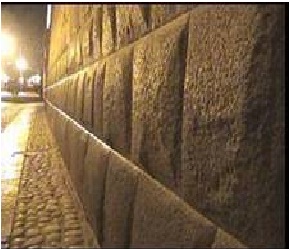
Vitrified Joints on a Wall in Cuzco
Archaeologists assume that the perfect fitting stones are the most developed style of the Incas. Regardless, there is no explanation of the shiny surfaces that can be observed. These often appear on the borders where the stones join perfectly. It is normally assumed that these parts were simply polished by the Incas.
During many visits to the vestiges mentioned, Jesus Gamarra and Jan Peter de Jong have examined these stones with highly reflective surfaces. They have captured many of them on video. Through personal observations and analysis of the video material, they have concluded that something other than polishing has occurred.
Identifying
Vitrified Stones.
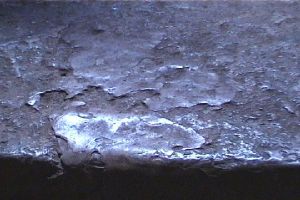
Amazing Vitrified Surface on the Altar in the Temple of
the Moon
Many cases display some or all of the qualities mentioned below. The vitrified spots show discoloration and smoothness around the particular areas. They clearly look like the stone has been melted just in those spots. A simple flashlight test was developed, to help identify the layers of glaze or glass.
Filming was carried out at night with a flashlight beam passing through the glaze. This shows the reflection and diffraction of the light as it passes through the surface. Sacsayhuaman, Kenko and Loreto Street were all filmed at night using a flashlight or the nocturnal illumination to capture the effect.
The following traits help to identify vitrified stones:
- The melted effect is obvious
- Reflection is high
- The layer refracts, diffracts and diffuses light
- A separate vitrified layer is present on the surface
- Damaged layers show a ´film´ on the stone
- The glazed layer is independent of rock type
- The surface is smooth to the touch even if the surface is irregular
- There is often associated heat discoloration surrounding the glaze
The diffraction effect can be seen in the video of ‘the Inca Throne’ at Sacsayhuaman. The rainbow effect is clearly captured by the camera. This is directly linked to the light passing through the glass layer and splitting into its constituent parts. After noticing this effect, it was also detected on videos of other vitrified stones. This can be viewed on this short video: http://www.youtube.com/watch?v=ae_8ri2fiwI, and on the DVD that will be available shortly.
VITRIFIED
STONE SAMPLE ANALYSIS
A small sample from the Peruvian site called Tetecaca was collected and then analyzed by the University of Utrecht, Holland.

Inside the Cave there are man made surfaces
The sample is from a rock outcrop above Cuzco. Inside the cave there is an altar formed from rectangular shapes made of the rock. Several lines in the rock have a shiny surface, as if they were branded into the rock. They are on right lines on the wall of the cave. The walls are cut out with curved and rectangular forms in them. These are man made structures, which rules out natural phenomena. The photos show the site.
Pictures from inside of the cave, walls with
long, straight reflecting lines and an altar structure:

Vitrified Altar Stone from the Cave

Vertical Track of vitrification in the Cave
Below is a picture of the spot where the sample was found. The white line indicates where the thin section was made. The smooth layer on the picture is about 2 cm wide and 1.3 cm deep. The sample was carefully cut into two parts and a thin section was taken for analysis.

The Sample Track Site
RESULTS
& CONCLUSION
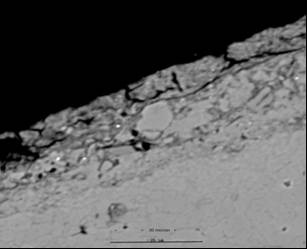
Microscope Picture of Sample
Microscope
Photos
The microscope photograph of the sample shows two distinct regions, the surface layer and the body stone. There is a less distinct intermediate area between the two that seems to transition from stone body to surface layer. Samples from all three regions were subjected to detailed analysis.
Photo 1: The Vitrified Surface of the Stone
(The line at bottom is 21 micrometer)
Spectral analysis
Composition of the Surface Layer
The body of the stone is limestone, which is not surprising. However, The Vitrified Surface of the stone shows a different spectrum of elements. (See spectra above) The glaring difference is that Silicon is present with much higher concentrations. The trace elements of Aluminum and Magnesium are also significantly higher than the body. Oxygen is also present in double the quantities. The Calcium and Carbon are much lower than the body sample.
The intermediate regions show a gradation between the surface and body of the stone. This implies either the surface layer was somehow ground and mixed with the stone body. The body limestone somehow merged/melted with the surface layer. Alternatively, the limestone constituents could have been a part of the added surface layer.
The surface shows some similarity to Wollastonite, which forms when impure limestone is subjected to high temperatures and pressures. However, the impurities in the surface are not present in the stone body. This indicates that the compounds in the surface layer were added. It appears they were applied and then treated with heat. This option does have some merits, but it is moving towards the techniques of the ceramist.
Whilst the spectra do not show explicitly that the surface is vitrified, the layer does have the composition, sheen, hardness and glassy texture of a glaze. It is very likely that the glaze was made from a ceramic paste applied to the limestone surface. This is reinforced with a comparison to ancient glazed ceramic pottery shards. If an antique ceramic is compared to the spectra of the glaze above there is little to separate the two. In the Paper X-Ray Techniques Applied to Surface Paintings of Ceramic Pottery Pieces From Aguada Culture (Catamarca, Argentina) there are several comparable results. Ignoring the gold leaf and colorants, the key constituents Silicon, Aluminum, Magnesium, Carbon and Oxygen are present in the same ratios.
The glazed results strongly indicate that heat was used to produce the finish. This raises several questions. Even if a layer of a ceramic paste was applied, how was it heated to the requisite temperatures without cracking the limestone? How was the heat produced to treat these structures? Whilst this sample is from a cave, there are similar structures that are outside with the same kind of glaze. The same conclusion may not necessarily be applied to these other cases.
Analysis is needed, but the similarities with the investigated sample and other photographed cases, are clear. It is likely that these other cases are also vitrified. The amount of heat needed to fire the huge stones on which these glazes are found is enormous. In furnaces, the whole body has to be raised to the temperature of the surface glaze.
DISCUSSION
The stones pictured above provoke much debate. Explanations on how they were produced vary from the use of advanced machines, simple metal/stone tools, molded stonework, concentrated sunlight and fire methods. Whilst the analysis above says little about the way the shapes were made, it does eliminate some ideas on the means of producing these exquisite finishes.
Heat is used to form glazes. How the heat was applied is not clear. To create ceramics on this scale, the heat production would have been greater than the normal ceramic methods.
Protzen has looked at these effects and suggested it could be achieved with polishing. To date, only Andesite has been attempted with very limited success. After the analysis of the surface layer above, it is clear that polishing alone will not produce the heat needed to produce a ceramic glaze. This eliminates polishing as a means of creation.
Peruvian Alfredo Gamarra has identified vitrification on many stones and has argued that the ancients had a technology to treat stone with heat and that the stone was soft at the moment of construction. The comparison at the spectrum level with clay and ceramic pastes is interesting. Ceramic pastes and clay are soft prior to being treated with heat.
Conventional geological understanding is not compatible with this idea. However, the impression from the vitrified stonework is that the stone was once soft. In many of the stones, there are places where it looks as if objects or molds were pressed into the stone. The perfect fitting stones in the walls of Cusco and the other Inca vestiges could have been obtained more easily this way.
Another option is the use of sun dishes and concentrated sunlight by the ancients. This is discussed by Prof. Watkins in his 1990 paper on fine Inca stonework. In this seminal paper, his chief concern was the methods of cutting the stone. Since he was proposing intense heat to cut the stones, it was not a great step to consider the stones melted. His conclusions have been much maligned since there had been no analyses performed.
The analysis does support this, but the location of the sample was on a wall in a cave. The ceramic paste had to be heated whilst on the stone vestige. This means light would have to be reflected deep into the cave. Whilst it is possible that the ancients were capable of producing flat mirrors for the task, it does seem complicated. This method could work for stones on the surface, but is clearly limited in this case.
If the stones were fired in a kiln, the glaze could be a result of the extremely high temperatures. The knowledge of ceramics in ancient Peru suggests this is a distinct possibility. This prospect however, only arises with the stones that can be placed in a kiln or stonework that is part of a kiln. The examples laid onto the sides of huge natural rocks cannot have been produced by standard fire techniques. As European studies of vitrified forts and experimental work have shown.
There is the possibility is that the cave itself was a kiln. Pots or vases may have been fired in the cave and the ceramic pastes may have been applied to protect the stone structure. There is much discoloration within the cave and innumerable glazed areas. The comparison to vitrified vestiges in the open air or in places without a smoke escape, leaves many questions.
On balance, it has to be admitted that a method is difficult to define. Further analysis of samples from the other sites needs to be undertaken to confirm the use of heat in all of the sites. However, the sample tested shows that the similarity to ceramic pastes is near certain. It is easy to conclude that heat was used. The treatment method may have been similar to the technology used for ceramic pastes, but on a much larger scale.
ACKNOWLEDGEMENTS
-Jesús Gamarra Farfan especially, for showing, explaining and filming these stones.
The following persons we want to thank for their cooperation and feedback:
-Prof. Schuiling, Tilly Bouten and Anita van Leeuwen, Geology department University of Utrecht.
-prof. Kars, Institute for Geo and Bioarchaeology, IGBA, Faculty of Earth and Life Sciences, Vrije Universiteit, Amsterdam
-David Campbell, http://www.anarchaeology.com
-Paul D. Burley, http://www.pauldburley.com
REFERENCES
-Jordan, C., The Ancient Solar Premise, Smashword edition, 2011, http://secretsofthesunsects.wordpress.com
-Gamarra Farfán, J.B., Parawayso. April 2008.
-de Jong, Jan Peter, www.ancient-mysteries-explained.com
-Morris, M., The great pyramid secret, Scribal arts 2010.
-Protzen, J.-P. l986. Inca stonemasonry. Scientific Amer. 254: 94-105.
-Prof. Watkins, I. 1990. How Did the Incas Create Such Beautiful Stonemasonry?” in “Rocks and Minerals” Vol. 65 Nov/Dec 1990.
-Thurlings, B, Wie hielp de mens? Uitgeverij Aspekt. 2008.
-X – Ray spectra of minerals and materials: http://www.cannonmicroprobe.com/XRay_%20Spectra.htm.
-Silvano R. Bertolino, Victor Galván Josa, Alejo C. Carreras, Andrés Laguens, Guillermo de la Fuente and José A. Riveros in Wiley Interscience Online, Dec. 2008. X-Ray Techniques Applied to Surface Paintings of Ceramic Pottery Pieces From Aguada Culture (Catamarca, Argentina).
Other Links
Jan Peter de Jong
website Ancient Mysteries Explained
Video The Cosmogony of the Three World
Christopher Jordan
Website Secrets of the Sun Sects
Books The Ancient Solar Premise , The Secrets of the Sun Sects
From Secrets of the Sun Sects @ http://secretsofthesunsects.wordpress.com/2011/12/05/incan-vitrified-stones/
The full details of this paper are available here or via the site Ancient Mysteries Explained
For more information about ancient mysteries see http://nexusilluminati.blogspot.com/search/label/forbidden%20archaeology
- Scroll down through ‘Older Posts’ at the end of each section
Hope you like this
not for profit site -
It takes hours of work every day by
a genuinely incapacitated invalid to maintain, write, edit, research,
illustrate and publish this website from a tiny cabin in a remote forest
Like what we do? Please give anything
you can -
Contribute any amount and receive at
least one New Illuminati eBook!
(You can use a card
securely if you don’t use Paypal)
Please click below -
Spare Bitcoin
change?
For further enlightening
information enter a word or phrase into the random synchronistic search box @
the top left of http://nexusilluminati.blogspot.com
And see
New Illuminati – http://nexusilluminati.blogspot.com
New Illuminati on Facebook - https://www.facebook.com/the.new.illuminati
New Illuminati Youtube Channel - http://www.youtube.com/user/newilluminati/feed
New Illuminati on Google+ @ https://plus.google.com/115562482213600937809/posts
New Illuminati on Twitter @ www.twitter.com/new_illuminati
New Illuminations –Art(icles) by
R. Ayana @ http://newilluminations.blogspot.com
The Her(m)etic Hermit - http://hermetic.blog.com
DISGRUNTLED SITE ADMINS PLEASE NOTE –
We provide a live link to your original material on your site (and
links via social networking services) - which raises your ranking on search
engines and helps spread your info further! This site is
published under Creative Commons Fair Use Copyright (unless an individual
article or other item is declared otherwise by the copyright holder). Reproduction
for non-profit use is permitted & encouraged, - if you give attribution to the work &
author. Please include a (preferably active) link to the original (along with
this or a similar notice).
Feel free to make non-commercial hard (printed) or software copies or
mirror sites - you never know how long something will stay glued to the web –
but remember attribution!
If you like what you see, please send a donation (no amount is too
small or too large) or leave a comment – and thanks for reading this far…
Live long and prosper! Together we can create the best of all possible
worlds…
From the New Illuminati – http://nexusilluminati.blogspot.com
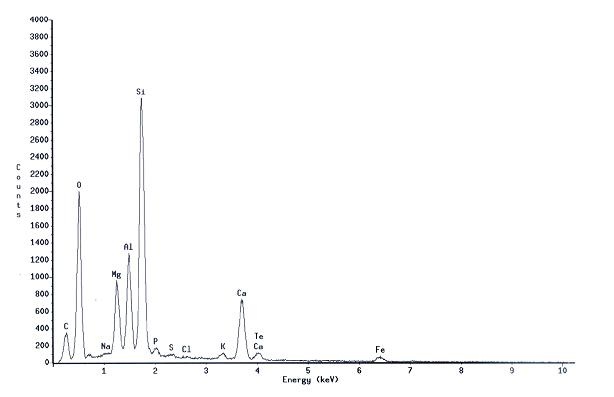
No comments:
Post a Comment
Add your perspective to the conscious collective